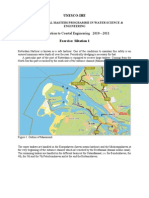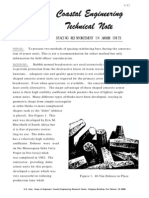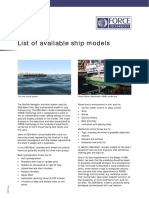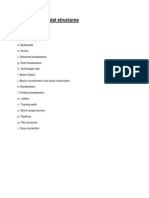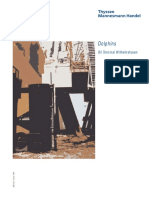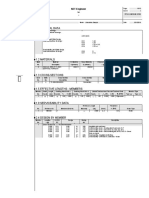0 ratings0% found this document useful (0 votes)
80 viewsChapter 10. Hydraulic Failure 185
This document provides guidance on analyzing the stability of retaining structures and earthworks according to EN 1997-1. It covers limit state design for ultimate and serviceability limit states. Chapter 9 addresses displacement-based design of retaining walls for vertical loads. Chapter 10 covers hydraulic failure modes, including uplift, heave, internal erosion, and piping. Chapter 11 discusses overall stability analysis of slopes and cuts. Chapter 12 presents considerations for embankment design, construction, and monitoring. The document provides examples to illustrate the limit state design methods.
Uploaded by
Yasonsky CaptainCopyright
© © All Rights Reserved
Available Formats
Download as PDF, TXT or read online on Scribd
0 ratings0% found this document useful (0 votes)
80 viewsChapter 10. Hydraulic Failure 185
This document provides guidance on analyzing the stability of retaining structures and earthworks according to EN 1997-1. It covers limit state design for ultimate and serviceability limit states. Chapter 9 addresses displacement-based design of retaining walls for vertical loads. Chapter 10 covers hydraulic failure modes, including uplift, heave, internal erosion, and piping. Chapter 11 discusses overall stability analysis of slopes and cuts. Chapter 12 presents considerations for embankment design, construction, and monitoring. The document provides examples to illustrate the limit state design methods.
Uploaded by
Yasonsky CaptainCopyright
© © All Rights Reserved
Available Formats
Download as PDF, TXT or read online on Scribd
You are on page 1/ 1
DESIGNERS GUIDE TO EN 1997-1
9.8.1. General
9.8.2. Displacements
Example 9.1: ULS design of a stem (gravity) wall
Example 9.2: ULS and SLS design of an embedded sheet pile wall
160
161
161
173
Chapter 10. Hydraulic failure
10.1. General
10.2. Failure by uplift (UPL)
10.2.1. General
10.2.2. Submerged structures
10.2.3. Design against uplift of an impermeable layer
10.2.4. Worked example of a design against uplift
10.3. Failure by heave (HYD)
10.3.1. General
10.3.2. Design using total stresses
10.3.3. Design using submerged weight
10.3.4. Determination of the relevant pore water pressure
10.3.5. Worked example of a design against failure by heave
10.3.6. Discussion on failure by uplift and failure by heave
10.4. Internal erosion
10.4.1. Filter criteria and hydraulic criteria
10.4.2. Effects of material transport
10.5. Failure by piping
10.5.1. General
10.5.2. Design against failure by piping
185
185
186
186
187
188
188
189
189
189
190
190
191
191
191
191
192
192
192
192
Chapter 11. Overall stability
11.1. General
11.2. Limit states
11.3. Actions and design situations
11.4. Design and construction considerations
11.5. Ultimate limit state design
11.6. Serviceability limit state design
11.7. Monitoring
Example 11.1: overall stability of a cutting in stiff clay
195
195
195
196
196
196
201
202
202
Chapter 12. Embankments
12.1. General
12.2. Limit states
12.3. Actions and design situations
12.4. Design and construction considerations
12.5. Ultimate limit state design
12.6. Serviceability limit state design
12.7. Supervision and monitoring
207
207
207
208
208
208
208
208
References
211
Index
213
You might also like
- Introduction To Coastal Engineering 2010 - 2011: Unesco-IheNo ratings yetIntroduction To Coastal Engineering 2010 - 2011: Unesco-Ihe4 pages
- Efficiency of Container and Bulk Cargo PortsNo ratings yetEfficiency of Container and Bulk Cargo Ports46 pages
- A Case Study of The New Breakwater of The Port of GenovaNo ratings yetA Case Study of The New Breakwater of The Port of Genova43 pages
- Self-Taught Education Unit: Coastal Shoreline Defense StructuresNo ratings yetSelf-Taught Education Unit: Coastal Shoreline Defense Structures19 pages
- Crest Modifications To Reduce Wave OvertNo ratings yetCrest Modifications To Reduce Wave Overt20 pages
- Design and Material Selection For Quality - Volume 1No ratings yetDesign and Material Selection For Quality - Volume 11 page
- New Edition of Admiralty Mariners Handbook np100 PDFNo ratings yetNew Edition of Admiralty Mariners Handbook np100 PDF1 page
- Comparative Analysis and Design of RCC Circular and Rectangular Shape Water Tank Resting On GroundNo ratings yetComparative Analysis and Design of RCC Circular and Rectangular Shape Water Tank Resting On Ground3 pages
- Fender Design For Latest Container ShipsNo ratings yetFender Design For Latest Container Ships21 pages
- Guide To Design of Structures For Robustness - CNDR 2021No ratings yetGuide To Design of Structures For Robustness - CNDR 2021150 pages
- SimFlex Navigator - List of Ship Model +++No ratings yetSimFlex Navigator - List of Ship Model +++9 pages
- THE Design OF Upright Breakwaters: Depart - Ent of Civil Engineering Yokoha.a National University, Yokoha.a 240, JapanNo ratings yetTHE Design OF Upright Breakwaters: Depart - Ent of Civil Engineering Yokoha.a National University, Yokoha.a 240, Japan22 pages
- BAM Clough Brochure270313single PageswebNo ratings yetBAM Clough Brochure270313single Pagesweb6 pages
- Breakwater, Artificial Offshore Structure Protecting A: HarbourNo ratings yetBreakwater, Artificial Offshore Structure Protecting A: Harbour3 pages
- Position Paper Bollard Loads On Port Infrastructure PIANC FinalNo ratings yetPosition Paper Bollard Loads On Port Infrastructure PIANC Final13 pages
- Floating Dolphins Floating Dolphins Floating Dolphins: 650.01 GeneralNo ratings yetFloating Dolphins Floating Dolphins Floating Dolphins: 650.01 General12 pages
- Cost Comparison - CP01 - Geotube and Barge - 2023 10 18No ratings yetCost Comparison - CP01 - Geotube and Barge - 2023 10 182 pages
- Waves and Wave Forces On Coastal and Ocean Structures: Robert T. Hudspeth0% (1)Waves and Wave Forces On Coastal and Ocean Structures: Robert T. Hudspeth954 pages
- Failure of Slopes and Soil Property Characterisation PDFNo ratings yetFailure of Slopes and Soil Property Characterisation PDF13 pages
- PIANC WG 40: Guidelines For The Design and Construction of Berm BreakwatersNo ratings yetPIANC WG 40: Guidelines For The Design and Construction of Berm Breakwaters14 pages
- PWDM - 2023 - E-Version June 2023 - p2 - 1 - 124No ratings yetPWDM - 2023 - E-Version June 2023 - p2 - 1 - 124126 pages
- Rock Riprap Design Methods and Their Applicability To Long-Term Protection of Uranium Mill Tailings ImpoundmentsNo ratings yetRock Riprap Design Methods and Their Applicability To Long-Term Protection of Uranium Mill Tailings Impoundments98 pages
- Adapting Cities To Sea Level Rise A Perspectiv 2017 Advances in Climate ChaNo ratings yetAdapting Cities To Sea Level Rise A Perspectiv 2017 Advances in Climate Cha7 pages
- Strandhill Beach - Coastal Erosion Studyc - Final - Draft67% (3)Strandhill Beach - Coastal Erosion Studyc - Final - Draft45 pages
- 1589309822-04 - Principles of Coastal EngineeringNo ratings yet1589309822-04 - Principles of Coastal Engineering43 pages
- Harbour Works (Break Water) 15. - 17.01.2023 PDFNo ratings yetHarbour Works (Break Water) 15. - 17.01.2023 PDF50 pages
- Local Wind Assessment in Australia: Computation Methodology For Wind Multipliers IIINo ratings yetLocal Wind Assessment in Australia: Computation Methodology For Wind Multipliers III1 page
- As-NZS.1170.2.2011 Structural Design Actions Part 2 - Wind ActionsNo ratings yetAs-NZS.1170.2.2011 Structural Design Actions Part 2 - Wind Actions1 page
- List of Figures: Local Wind Assessment in Australia: Computation Methodology For Wind Multipliers VNo ratings yetList of Figures: Local Wind Assessment in Australia: Computation Methodology For Wind Multipliers V1 page
- As-NZS.1170.1.2002 Structural Design Action Part 1 Permanent, Imposed and OtherNo ratings yetAs-NZS.1170.1.2002 Structural Design Action Part 1 Permanent, Imposed and Other1 page
- Curtain Wall Fabrication Drawing Guide: by Edgardo M. BernardinoNo ratings yetCurtain Wall Fabrication Drawing Guide: by Edgardo M. Bernardino1 page



